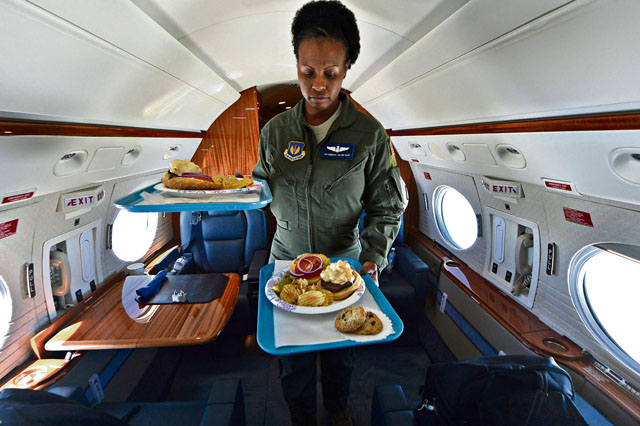
The highly polished wood surfaces, soft reclining leather seats and large, bright windows lining the C-37 Gulfstream are indicative of its distinguished passengers and the class of the professionals serving them.
The 76th Airlift Squadron flight attendants are among the few selected across the Air Force to represent the military in assisting world leaders.
While their job consists of grocery shopping, coordinating, prepping, cooking and serving meals, as well as cleaning and loading luggage, onboard aircraft safety is their primary responsibility.
“The biggest misconception about our job is that it’s as easy as being a commercial flight attendant,” said Tech. Sgt. Cheneldra Moore, 76 AS flight attendant. “The commercial airlines would hire at least three to four different positions to do what’s all-encompassing in our job title.”
In order to work on an aircraft, they must first pass evaluations in egress duties and emergency procedures.
All U.S. Air Force flyers are taught basic aircraft fundamentals, yet every aircraft has its own set of procedures that the flight attendants must learn when they are assigned to a new aircraft to become mission-qualified.
Staff Sgt. Ashleen Martinez, 76 AS flight attendant, welcomed Moore aboard her first Gulfstream flight.
“My job today is making sure my new students learn about the aircraft and understand this jet,” Martinez said.
Martinez teaches the differences of working as a solo flight attendant versus Moore’s previous roles of working within a team the past ten years.
The flight attendants go through the preflight checklist ensuring all equipment is serviceable then secure the cabin for takeoff. Soon after the seat belt sign disappears, they begin cooking.
The Airmen act as chefs, navigating the compact kitchen to prep and serve hot dishes to their notable passengers and the crew.
Multitasking and time management are key to being proficient in this labor-intensive job, Moore said.
“I’ve learned how to be productive in small amounts of time with big responsibilities,” Moore added. “Our motto is safety, comfort and reliability; in that, you tend to put yourself last to make sure everyone else is taken care of.”
Flying around the globe week to week, jumping time zones and living out of luggage is a lifestyle that comes with its challenges.
“I think the physical labor is the most challenging part of the job, from lifting equipment, standing on our feet all the time to being awake when everyone else is asleep,” Moore said. “We are the safety experts, so we have to be up and sometimes we forget to take care of ourselves.”
“We barely eat or drink water, but it’s worth it,” Martinez said. “I like the longer missions because you a have a chance to go to the bathroom.”
According to the 76 AS Aviation Resource Management office, the 24 flight attendants in the 76 AS average approximately 25 missions a month. Mission lengths can vary from one to 15 days.
With all the traveling, both Moore and Martinez explained that they love their job.
“I like interacting with different people,” Martinez said, who wanted to be a commercial flight attendant but also stay close to her military roots.
Some of the leaders they have worked for are only seen on television by most people.
“We get to work and interact with our nation’s leaders,” Moore said. “It’s one of the best jobs in the Air Force.”
The once special duty is now a career assignment, only available to current service members looking to cross train. Applicants have to go through a records review, flight physical and security clearance and obtain five letters of recommendation to be eligible.
For more information on applying, visit the myPERS website.


